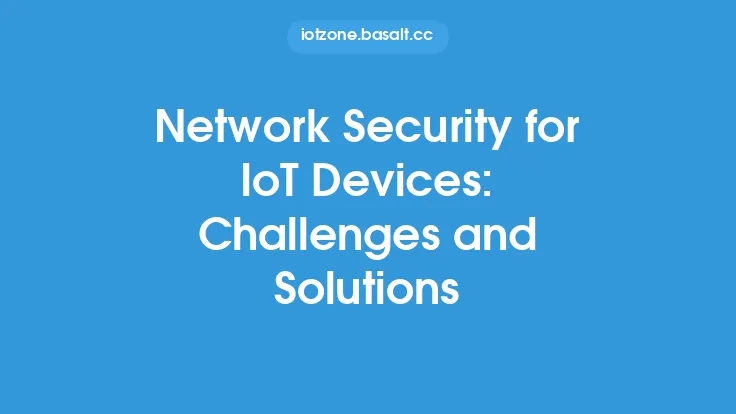The increasing number of Internet of Things (IoT) devices has led to a growing concern about the security and privacy of the data they transmit and receive. One of the most effective ways to ensure the confidentiality and integrity of IoT data is through the use of end-to-end encryption (E2EE). In this article, we will delve into the benefits and challenges of implementing E2EE for IoT devices, exploring the technical aspects and real-world implications of this security measure.
What is End-to-End Encryption?
End-to-end encryption is a method of secure communication where only the sender and the intended recipient can read the data being transmitted. This is achieved by encrypting the data at the source (the IoT device) and decrypting it only at the destination (the intended recipient's device or server). E2EE ensures that even if the data is intercepted or accessed by an unauthorized party, it will be unreadable without the decryption key.
Benefits of End-to-End Encryption for IoT
The benefits of E2EE for IoT devices are numerous. Firstly, it provides a high level of confidentiality and privacy for the data being transmitted. This is particularly important for IoT devices that handle sensitive information, such as personal data, financial information, or confidential business data. Secondly, E2EE ensures the integrity of the data, preventing tampering or alteration during transmission. This is critical for IoT devices that rely on accurate and reliable data to function correctly. Finally, E2EE helps to prevent man-in-the-middle (MITM) attacks, where an attacker intercepts and alters the communication between two parties.
Challenges of Implementing End-to-End Encryption for IoT
Despite the benefits of E2EE, there are several challenges associated with implementing it for IoT devices. One of the main challenges is the limited computational resources and power available on many IoT devices. E2EE requires significant computational resources to perform the encryption and decryption operations, which can be a challenge for devices with limited processing power and memory. Another challenge is the need for secure key management, which can be complex and difficult to implement, particularly in large-scale IoT deployments. Additionally, E2EE can introduce latency and overhead, which can impact the performance and responsiveness of IoT devices.
Technical Requirements for End-to-End Encryption in IoT
To implement E2EE for IoT devices, several technical requirements must be met. Firstly, the IoT device must have a secure and reliable way to generate and store cryptographic keys. This can be achieved through the use of secure key generation algorithms and secure storage mechanisms, such as trusted execution environments (TEEs) or hardware security modules (HSMs). Secondly, the IoT device must have a secure and efficient encryption algorithm, such as the Advanced Encryption Standard (AES) or the Elliptic Curve Cryptography (ECC) algorithm. Finally, the IoT device must have a secure and reliable way to authenticate and verify the identity of the intended recipient, which can be achieved through the use of digital certificates or other authentication mechanisms.
Real-World Examples of End-to-End Encryption in IoT
There are several real-world examples of E2EE being used in IoT deployments. For example, many smart home devices, such as security cameras and door locks, use E2EE to secure the communication between the device and the cloud or mobile app. Similarly, many industrial IoT devices, such as sensors and actuators, use E2EE to secure the communication between the device and the control system or cloud. Additionally, many IoT platforms and protocols, such as the IoT protocol MQTT, support E2EE as a standard feature.
Best Practices for Implementing End-to-End Encryption in IoT
To ensure the effective implementation of E2EE in IoT devices, several best practices should be followed. Firstly, the IoT device should use a secure and reliable encryption algorithm, such as AES or ECC. Secondly, the IoT device should use secure key management practices, such as secure key generation and storage. Thirdly, the IoT device should use secure authentication and verification mechanisms, such as digital certificates or other authentication protocols. Finally, the IoT device should be designed and implemented with security in mind, using secure coding practices and secure development methodologies.
Future of End-to-End Encryption in IoT
The future of E2EE in IoT is promising, with many organizations and industries recognizing the importance of securing IoT data. As the number of IoT devices continues to grow, the need for E2EE will become increasingly important. Additionally, the development of new technologies, such as quantum-resistant encryption and homomorphic encryption, will provide even more secure and efficient ways to implement E2EE in IoT devices. However, the challenges associated with implementing E2EE, such as limited computational resources and secure key management, will need to be addressed through the development of new technologies and standards.
Conclusion
In conclusion, end-to-end encryption is a critical security measure for IoT devices, providing a high level of confidentiality, integrity, and authenticity for the data being transmitted. While there are challenges associated with implementing E2EE, such as limited computational resources and secure key management, the benefits of E2EE make it an essential component of any IoT security strategy. By following best practices and using secure encryption algorithms and key management practices, organizations can ensure the effective implementation of E2EE in their IoT devices, protecting their data and preventing cyber threats. As the IoT continues to grow and evolve, the importance of E2EE will only continue to increase, making it a critical component of any IoT security strategy.





